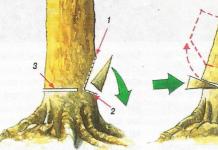Asparagus species are diverse: herbaceous plants, shrubs and shrubs, lianas. Asparagus translated from Greek means "young growth". Man has long learned to use this plant for his own benefit. The oldest image of asparagus (3 thousand BC) was found in Egypt, and the ancient Roman culinary author Apicius in his treatises praised the taste of asparagus (the widespread name for asparagus - "asparagus" came to us from the Italian language). The asparagus family includes more than 300 species, which are very different from each other.
The appearance of asparagus is a bit unusual:
- the aerial part includes phylloclades / cladodia (stems), on them - triangular scales-leaves (in some species - thorns);
- underground part - tubers, bulbs and roots.
Did you know?Asparagus are able to quickly adapt to new biocenoses and actively spread (birds carry their seeds). The asparagus exported from South Africa have wonderfully taken root in Australia and America and are recognized there as harmful weeds, they are being fought with.
Common Asparagus (Asparagus officinalis)
This perennial herb is also often called medicinal or pharmaceutical asparagus. Asparagus vulgaris grows with smooth and straight stems (30 to 150 cm high). Phylloclades are thin, oblique and directed upward (from 1 to 3 cm long), grow in bunches (from 3 to 6). Scaly leaves with spurs. Flowers - white-yellow, single or paired (blooms in June). The berries are red. Pharmacy asparagus is grown for the sake of its shoots (table varieties) - they are cut off about 20 cm from the top. If the plant is protected from the sun, the shoots will be white, if grown in the sun - green. 
Important!Sulfur compounds in asparagus shoots can alter a person's body odor (like garlic or onions).
White shoots contain more vitamins (B1, B2, asparagine, minerals). Greens contain more chlorophyll and taste better. Asparagus asparagus is low in calories, has a beneficial effect on the heart and blood vessels (lowers blood cholesterol levels), on the skin, eyesight, nervous system, has anti-cancer and bactericidal properties.
Asparagus asparagoides
Asparagus asparagus (there is another name for asparagus - asparagus) was first described in 1753 by K. Linnaeus. Originally grown in the south and east of the African continent.
 The bushy creeping plant has bare stems, flexible thin shoots of light green color. It can grow up to 1.7 m tall. Its phylloclades are interesting, they resemble leaves - lanceolate, bright green in color with shine (width 2 cm, length 4 cm). It blooms with small white-milky flowers with an orange scent. The berries are bright orange.
The bushy creeping plant has bare stems, flexible thin shoots of light green color. It can grow up to 1.7 m tall. Its phylloclades are interesting, they resemble leaves - lanceolate, bright green in color with shine (width 2 cm, length 4 cm). It blooms with small white-milky flowers with an orange scent. The berries are bright orange.
This type of asparagus cannot tolerate low temperatures (12 degrees Celsius is already low), does not like prolonged heat.
Important! Asparagus prefer slightly acidic soils (pH 5.5-7.0). Combinations of mixtures favorable for the growth of asparagus: humus, sand, leafy soil (1x0.5x1); turf, leafy soil, humus, sand (2x2x2x1).
Asparagus racemosus (Asparagus racemosus)
The semi-shrub plant has climbing stems (can reach 2 m), phylloclades grow in bunches. It blooms with bright pink flowers (cluster inflorescences, hence the official name). The flowers have a delicate scent. The berries are scarlet.
 The homeland of asparagus racemose is South Asia (Nepal, India, Sri Lanka). Likes to grow in rock conditions. Here he is called satavar (shatavari) - "healer of a hundred diseases." Due to mass production in the wild, it is almost never found. It was discovered by Europeans in 1799.
The homeland of asparagus racemose is South Asia (Nepal, India, Sri Lanka). Likes to grow in rock conditions. Here he is called satavar (shatavari) - "healer of a hundred diseases." Due to mass production in the wild, it is almost never found. It was discovered by Europeans in 1799.
Important! Asparagus do not like dry land and moisture stagnation. Watering should be plentiful, and spraying should be at any time of the year.
Asparagus plumose (Asparagus plumosus)
A short shrub has curved, highly branching stems, side shoots are needle-shaped (15 mm, 0.5 mm in diameter), grow in bunches (from 3 to 12). The flowers are white (it does not bloom when kept indoors), the berries are blue-black. The plant is native to South Africa. 
- does not tolerate direct sunlight - it is covered with brown spots;
- requires frequent watering and spraying (at temperatures above 15 degrees Celsius);
- the best soil for it is a mixture of peat and sand.
Asparagus pinnate is very popular because of its decorative effect, malleability (especially in China and Japan for making bonsai).
Asparagus meyeri
In natural conditions, it is found in South Africa and Mozambique. The first feature of this type of shrub is candle-like straight (up to 60 cm long) branches that grow from one center. Another feature is that thin and soft light green phylloclades grow densely and trim branches so that they resemble the furry tails of foxes. Therefore, it is also called the foxtail fern.
 Meyer's asparagus blooms in summer. Asparagus flowers are small, white in color and with a pleasant aroma. Fruits in bright red berries.
Meyer's asparagus blooms in summer. Asparagus flowers are small, white in color and with a pleasant aroma. Fruits in bright red berries.
In the spring, it requires a transplant, as it quickly develops the volume of soil. Does not like pruning and does not tolerate insecticides.
Did you know? The main enemies of asparagus are garden pests - scale insects, spider mites and thrips.
Asparagus medeoloides (Asparagus medeoloides)
It comes from South Africa, the Australian continent became the second homeland (here there is a local name - wedding vine. The leaves of asparagus (phyllocladia), intertwining with long and thin shoots, form a patterned canopy). Grown as an ampelous plant. It blooms with small white flowers, bears fruit with bright orange berries.
 Popular when decorating bouquets (branches after cutting can stand without water and not wither for a long time). When growing, it needs free space (can reach 1.5 m in height).
Popular when decorating bouquets (branches after cutting can stand without water and not wither for a long time). When growing, it needs free space (can reach 1.5 m in height).
Important! Asparagus berries are poisonous, if they are present on the plant, it is necessary to limit the access of children and pets to it. Gloves should be used when removing seeds.
Asparagus the finest (Asparagus benuissimus)
The description of the finest asparagus practically does not differ from the pinnate asparagus, with the exception of:
- longer and rarer phylloclades;
- shoot lengths - can grow up to 1.5 m.
Blooms in summer, small white flowers. The berries are black.
Asparagus crescent (Asparagus falcatus)
Comes from South Africa. It is a liana (in nature it can reach 15 m) of a dark green color. The name was given because of the shape of the phylloclades - in the form of a sickle (length up to 8 cm). It blooms in loose inflorescences of white small fragrant flowers (from 5 to 7).
 Asparagus crescent has a high growth rate (grows well in shaded areas).
Asparagus crescent has a high growth rate (grows well in shaded areas).
Asparagus is a perennial plant with soft, narrow leaves. From a distance, the leaves can be mistaken for needles, but they have nothing to do with thorns. Although it can bloom, it is prized for its delicate foliage. The plant belongs to the Asparagus family. Some species are indeed edible, like the notorious asparagus, but decorative varieties are more popular in culture. They are distributed throughout the globe, in various climatic zones. The homeland of certain species of asparagus is Western Europe, USA, India, Japan, Egypt. In our country, the plant is common in indoor culture. When properly cared for, asparagus forms dense green growths.
Description of the plant
Asparagus is a perennial evergreen in the form of a bush or liana. The developed rhizome goes deep into the soil. First, an underground powerful shoot is formed from the bud, and only then a bunch of terrestrial shoots grows from it. The plant has soft herbaceous stems. Flexible green shoots up to 1.5 m long take an active part in photosynthesis. They are covered with scaly, often poorly developed, leaflets. What ordinary people mistake for narrow foliage are actually short, needle-shaped twigs (cladodia). They grow in bunches on a longer shoot. At the base of the cladodia, hard scaly leaves with hard spurs can be seen.















Flowers on young shoots bloom singly or in small corymbose inflorescences. Indoors, flowering is extremely rare. Flowers grow in the leaf axils. A symmetrical corolla is either bisexual or unisexual. It consists of six small petals growing in 2 tiers and the same number of filamentous stamens. The three-nested ovary in the center of the flower has a short column with a stigma. When the flowers wither, small, rounded berries with small seeds ripen. Juicy pulp is hidden under the thin red skin.
Asparagus berries are inedible! Like shoots, they are poisonous, so it is better for children and animals not to approach the plant.
Asparagus varieties
The genus of asparagus is very diverse and numerous. More than 200 plant species are numbered among it.
The inhabitant of the subtropical and tropical forests of Africa grows in the form of a semi-shrub with climbing shoots. Strongly branched naked stems are covered with scaly triangular foliage up to 5 mm long. Filamentous shoots (phylloclades) 5-15 mm long grow in groups of 3-12 pieces. Due to the lateral processes in the horizontal plane, a single shoot resembles a multiple dissected fern leaf. Small white flowers bloom singly. After pollination, blue-black berries with 1-3 seeds ripen.

The semi-shrub grows single shoots up to 50 cm long. They are densely pubescent and covered along their entire length with bright green cladodia, similar to needles. The shoots grow in all directions. Outwardly, each shoot resembles a fluffy brush.

The creeping shrub lives on the humid mountain slopes of South Africa. The bare branched stems droop to the ground and grow up to 1.5 m in length. Subulate scaly leaves up to 4 mm long surround bundles of 2-4 straight or curved phylloclades up to 3 cm in length. Delicate pink or white flowers with a pleasant aroma are collected in loose corymbose inflorescences. After pollination, red round berries ripen.

The liana-like variety grows flexible stems up to 15 m long and up to 1 cm thick.In indoor conditions, the length of the vines does not exceed 4 m.On the shoots, at a great distance from each other, there are large crescent-shaped cladodia about 8 cm long.The plant tolerates pruning better than others and forms lateral processes. It blooms in loose fragrant panicles with small creamy flowers.

The inhabitant of the temperate climate comes from North Africa. Its herbaceous shoots grow up to 30-150 cm. The smooth surface of the appendix is covered with bundles of filamentous cladodia. Scaly leaves with spurs grow at their base.

Shoots on a shrub 50-150 cm high grow vertically. They are densely covered with short dark green phylloclades, which are located in the same plane. Although the leaves are as soft to the touch, they can be mistaken for a juniper from a distance.

Reproduction methods
At home, asparagus is propagated by seeds, cuttings and rhizome division. Seeds are removed from ripe berries and immediately sown in pots with loose, fertile soil. They are sprinkled with a thin layer of earth, watered and placed in a warm, lighted place. To prevent moisture from evaporating too quickly, cover the container with a film. Shoots appear in 2-3 weeks. The film is removed, but the soil is regularly sprayed. When the stems grow 7-10 cm in length, the seedlings dive. Plants develop slowly at first, but gradually grow into a lush green cloud.
Cuttings 8-10 cm long are cut in the spring. They are rooted in wet sand under a transparent hood. The plants should be kept in diffused light and at a temperature of + 20 ... + 23 ° C. The seedlings are ventilated and sprayed daily. The cutting will take root and adapt properly in 1-1.5 months, then the shelter is removed and the asparagus is transplanted into the soil.

In the spring, during transplantation, a large bush can be divided. Usually, the lateral processes with their own roots are cut off. They are planted in separate small pots.
Planting and caring for the plant
The roots and stems of asparagus grow quickly, so the flower is transplanted annually. The best time for manipulation is early spring. The rhizome is removed from the pot, the old soil is removed and some of the underground processes are cut off. Old branches are also removed. Young shoots will appear soon. The pot should be spacious enough, because sometimes tight containers even burst under the onslaught of rhizomes. The soil for planting is slightly acidic, loose and nutritious. It can be composed of the following components:
- sheet soil;
- sod soil;
- sand.

Lighting. In nature, asparagus grows in the shade of tropical trees, so it will dry out in direct sunlight. The light should be bright but diffused. In a dark room, cladodes become yellowish and faded. The pot is placed in the back of the southern room or on the sill of the eastern (western) window. In the northern room, there will be little light and you will have to use backlighting.
Temperature. In good lighting conditions, the optimum air temperature is + 20… + 24 ° C. In hot summer, it is useful to take the flower outside in a shady place protected from strong winds. If this is not possible, the room is often ventilated. In winter, with a short daylight hours, a cold snap to + 10 ° C will not allow the shoots to stretch out too much.

Watering. Water the asparagus often and abundantly. Water is well defended to get rid of chlorine. The earth should not dry out even on the surface, but stagnation of water is not allowed either. With a lack of liquid in the soil, asparagus leaves turn yellow and fall off. When the temperature drops, watering is reduced so that the fungus does not develop.
Fertilizer. Top dressing of asparagus is carried out only from April to October. Use a solution of mineral fertilizer for decorative deciduous plants. It is added to the soil instead of watering twice a month.
Crown formation. Most asparagus species have a very specific attitude towards pruning. Initially, an underground bud develops, from which the shoot grows. If the stem is cut to the required length, lateral processes and phylloclades are not formed and further development will stop. The plant will begin to form a new bud. Only asparagus sickle can be cut. They create support for the rest of the species and figure out how to decoratively twist the shoots, no matter how long they are. Use a ladder, decorative spiral, line guides, or allow the stems to hang from the planter. On the old bush, the bare and drying out processes are cut off.

Diseases and pests. It is only with prolonged flooding of the soil and low temperatures that asparagus affects root rot. Other diseases are not terrible for the plant. The main pest is the spider mite. It attacks most often when the air is too hot and dry. Sometimes it is enough to rinse the shoots under a hot shower (up to 45 ° C). In advanced cases, insecticides are used.
Uses of asparagus
The beautiful airy greens of asparagus are very popular with flower growers. Plant pots can be found in corridors and rooms of residential buildings, offices and government agencies. Also, lush twigs, similar to a herringbone, are cut to decorate bouquets.
Common asparagus is used for food. This is the well-known asparagus. It is grown in the garden as a vegetable crop. Harvested underground stems (about 18-20 cm long) with an unblown bud. The shoots are rich in vitamins and active elements. They are canned and boiled. The dish tastes like green peas.

Asparagus roots contain ascorbic acid, saponins, asparagine alkaloid, coumarins, amino acids, mineral salts. Decoctions and infusions are made of them, which help to cope with the following ailments:
- jaundice;
- infertility;
- gout;
- diabetes;
- tachycardia;
- epilepsy;
- rheumatism.
The drugs have lactic, diaphoretic, analgesic, antibacterial, immunomodulatory effects. Various peoples have been using them for over 2,000 years.
Asparagus (Asparagus) - perennial... Previously, this representative of the flora belonged to the Liliaceae family. But, at the moment, asparagus crops are isolated into a separate family. Therefore, now Asparagus belongs to the Asparagaceae family.
It grows actively in Europe, Siberia, the Caucasus, China, Australia, the USA, on the Mediterranean coast. It can be a sprawling bush, emerald grass, or liana. The branches of Asparagus reach a height of more than 150 cm. They are endowed with small flattened branches with bundle-shaped cladodia.
Claudia are located on stems and scaly leaves. Leaves are miniature, underdeveloped or completely absent. There are hard spurs on the trunk. The plant has a well-developed root system.
Asparagus species and names
The genus of this representative of the flora includes more than 300 different types.
They are all united by a single growth rhythm. At the initial stage of growth, future shoots are formed in an underground bud. Further, the shoot begins to gradually increase. But new organs are not formed on the stem.
Therefore, when the crown is formed, the shoots stop growing. The root system will begin to form underground buds again. This feature when growing Asparagus must be taken into account before growing. All subspecies of this representative of the flora are subdivided into indoor and garden.
Room representatives
Indoor types of asparagus get along well at home... Such plants can grow in deep pots, wide bowls on windowsills. Basically, they are installed next to windows or in light spacious balconies.
The soil for such plants is chosen neutral or slightly acidic. Top dressing is applied along with irrigation. Watering is carried out as the topsoil dries up. As for the diseases that asparagus and pests are susceptible to, detailed information can be found.
The main indoor subspecies include:
The main garden subspecies include:
(Asparagus officinalis) is a perennial dioecious herb. It reaches a height of no more than 1.5 m. It has straight branched stems, which are covered with graceful cladodia. The stems bend strongly under their own weight. Leaves are elongated, scaly. Flowers are amber-white, growing on elongated legs.
(Asparagus L.) is a branchy frost-resistant perennial. It is a source of medicinal raw materials. It is used in cooking. Contains essential oils, vitamins and minerals. The plant reaches a height of 1.5-2 m. It has a large number of needle-like processes. It has a powerful root system that forms growth buds.
Green asparagus is a highly branched perennial. Possesses a powerful root system. Has miniature, underdeveloped leaves. The flowers are small, of both sexes. After flowering, oval blue-black berries form. The sprouts of this representative of the flora are used in cooking. They contain antioxidants, fiber, vitamins, trace elements. The harvest takes place in May-June.
See below: asparagus photo

White asparagus

Medicinal asparagus

Green asparagus
Important! Garden plants should not be planted near groundwater. A well-lit and windless place is chosen for landing.
Asparagus is a perennial plant. There are over 300 different subspecies. May become original decoration of flower arrangements... We are loved by florists for their delicate and graceful treasures. It responds well to top dressing. Easily tolerates drought and minor temperature fluctuations. Has become widespread throughout the world. About the benefits and dangers of asparagus- asparagus can be found on our website.
Useful video
Watch the video: Asparagus or asparagus. Types, care, breeding.
Advice! For a special aesthetic effect, plant asparagus in hanging basket... Its fluffy branches will hang beautifully from the pot.
Only some types of asparagus are suitable for indoor cultivation.
A. feathery
A climbing perennial shrub brought to us from the southern and eastern regions of Africa. Found in tropical and subtropical forests, savannah and mountains. The altered stems of pinnate asparagus are collected in bunches, the leaves are reduced to triangular scales half a centimeter in size. The flowers are small, they are found in pairs or singly. Blue berry black... One of the most common varieties is A. dwarf.
A. asparagus / asparagus
It grows naturally in the sands and mountains of South Africa. Has long light shoots and bright ovate green phylloclades (modified stems). The flowers are white, small. Fruit - orange smelling like an orange.
Idea! This look looks great in hanging baskets as well as in pots with branch supports. In addition, cut stems retain their freshness for a long time, therefore they are suitable for the formation of bouquets.
A. sickle
This is a real liana, the length of the branches of which in nature reaches 15 m, and in the greenhouse - 4 m. Unlike other species, the sickle asparagus tolerates pruning well, turning, as a result, into a rather lush bush. White small flowers look quite impressive and, moreover, have a pleasant smell.
A. Sprenger / Ethiopian
A herbaceous plant native to South Africa with bare branching stems and subulate scales instead of leaves. Phyloclades are single or collected in bunches. The flowers are pink and white, fragrant.
Advice! Choose this type if the room is very sunny. But do not forget about regular watering, especially during the summer.
A. Meyer
One of the most attractive types. It has straight, candle-shaped and very pubescent branches, which are compared either with the tail of a fluffy animal, or with a dish brush. Flowering falls in the summer. At that time Meyer's asparagus covered with white fragrant flowers, which later turn into red berries.
A. common / medicinal asparagus / pharmacy asparagus
It grows in North Africa, southern Europe, Asia, New Zealand. Stems are long, smooth with many branches and scaly leaves. Blooms in late spring with white leaves. Red- brown fruits appear in August.
Advice! If you are looking for a healthy vegetable for your garden, medicinal asparagus is ideal: its rhizomes contain a large amount of vitamins, seeds - oils, and fruits - carbohydrates and organic acids.
Planting and transplanting
Planting, as well as transplanting homemade asparagus, is carried out in the spring. You need to take care of the soil for the plant and immediately find a suitable place for it.
Asparagus feels best in a bright room, but not in direct sunlight. light... Therefore, you should focus on the eastern and western windowsills.
Asparagus loves slightly acidic soil - pH5.5-7.0. To compile a suitable soil, you will need humus, leafy soil and coarse sand in a ratio of 1: 1: 1/2. Another option: two parts of humus, sod and leafy land for one part of sand.
Do not forget about drainage to avoid stagnation of moisture in the roots. For these purposes, expanded clay can be used.
Young plants are transplanted annually, adult plants are transplanted as they grow, taking into account the size of the rhizome when choosing a pot.
Reproduction
There are three ways to reproduce asparagus at home: through seeds, dividing the bush and cuttings.
Division
Most often, reproduction by division is carried out in the spring, during plant transplantation. Depending on the size of the rhizome, it is divided into several parts, shortening the roots. They are planted in pots of appropriate size in the soil compiled according to the recipe described above.
Seeds
According to experts, seeds should be planted immediately after harvest, somewhere in January-March.
For planting, use a soil composed of sand and peat in equal parts. Before sowing the seeds, it is well watered. Having distributed the seeds over a moistened surface, the container is tightened with a film and exposed to light. The room should be warm enough - 20-22 ° C.
If condensation drops appear on the film, the seedlings are ventilated. A pick is made when the sprouts reach a height of 7-10 cm, and already in June the young are planted in permanent pots with a diameter of about 10 cm.A mixture of peat, sand, leafy, turfy land and humus in equal parts is used as a soil.
Cuttings
In this way, asparagus is propagated in early spring. They choose strong shoots and cut off cuttings about 10 cm long. For rooting, they are placed in a tray with sand and tightened with a film so that moisture is saved as best as possible. The room where the cuttings stand should be light and warm (20-22 ° C).
The cuttings should be aired and watered daily. A month later, when the roots appear, the asparagus is planted in pots and put in a permanent place.
Care
Consider the basic rules for caring for indoor asparagus.
Air temperature and humidity. In summer, the temperature in the room where the asparagus stands should be 20-25 ° C. If it is higher, the plant will start to hurt. In winter, the temperature is significantly reduced (12-15 ° C). Water the flower less often. If the temperature remains high, the asparagus stalks are slightly exposed. You will have to cut them off, but don't worry, new shoots will appear in February and the plant will turn as green as before. At this time, he will need more moisture.
Watering. In the summer, the asparagus is watered abundantly, but between waterings they wait for the ground to dry out. The pallet is freed from excess water. You can resort to bottom watering.
In winter, the volume of liquid is reduced, but watered regularly.
If the room is dry and warm, spray asparagus. It is also a good idea to fill the tray with expanded clay or gravel with water.
Lighting. It should be light in the room where the asparagus is standing. But direct sunlight has a detrimental effect on this plant (with the exception of A. Sprenger). Therefore, place the pot on the east or west window, or shade it with curtains, exposing it to the south windowsill.
In the summer, it's a good idea to bring the asparagus outdoors and in partial shade.
Advice! If you purchased the plant from a store, train it to bright light gradually, in order to avoid burns.
Top dressing. Asparagus welcomes mineral and organic fertilizers for indoor plants. The solution must be weak. During the warmer months, asparagus is fed weekly. And only once a month in winter.
Pruning. If an asparagus shoot is cut off, it will stop growing. The fact is that all the organs of the future shoot are formed even underground, and pruning forces the plant to start this preparatory stage anew.
Diseases and pests. Most of the problems with the appearance of asparagus are most often caused by not following the rules of caring for it.
So, if you notice burns on the shoots, as well as brown edges on the leaves, the reason may lie in excess sunlight and dry soil.
The main pests of asparagus are scale insects, aphids and spider mites. However, it is impossible to fight them using traditional methods. After all, washing needle-shaped leaves with soapy water is quite problematic, and asparagus reacts extremely negatively to chemicals.
The best preventive measure is a warm shower. It removes dust from the plant and prevents pests from multiplying.
Many flower lovers are interested in asparagus, since caring for it does not create serious problems for both an experienced specialist and a novice amateur. This undemandingness and hardiness of asparagus has earned the attention of plant lovers.
Despite the fact that this flower is sometimes supplanted for sale by plants with a more varied bright deciduous color, it may well become a wonderful element of decorative decoration for both a living room and an office space.
To grow this flower and turn it into a real decoration of the room, you need to know its features, and the article will help reveal some of the secrets of caring for it.
Asparagus
Asparagus is a houseplant home care that is interesting to many flower lovers. Today, homemade asparagus lives in many homes, as caring for asparagus at home is not difficult. Asparagus is an ornamental leafy plant. Many species are grown as indoor crops or for cutting.

The plant is also used as a garden plant, and some species have been used as vegetables since ancient times, for example, asparagus officinalis. The plant comes from the subtropics, tropics of the Old World, Asia, Africa. The genus consists of three 100 species that are outwardly different from each other. Home care for asparagus is almost the same regardless of the species. Know:
- The progenitors of the plant were brought to Europe more than 200 years ago.
- The plant begins to bloom at 5 or 6 years of age. The flowers are white, small, with a delicate pleasant aroma. Red berries that decorate the plant.
- Asparagus is a graceful plant due to its lush characteristic greenery, used for landscaping. Moreover, the flower looks amazing in vertical, horizontal and cascading positions.
- In indoor culture, the multifloral asparagus is best known, used as an ampelous plant, and its Sprengeri variety, called the emerald fern.
Fern comparison
In common use among flower lovers, asparagus is considered a fern, although the plant belongs to the asparagus family and has nothing in common with a fern except for its appearance. Asparagus shoots are similar to fronds. Openwork leaves are nothing more than leafy modified branches. The leaves of the plant are simple (reduced) - these are tiny brown scales that are difficult to see with the naked eye.
Asparagus is a genus of the asparagus family, which numbers more than 300 species. The most widely known of them is Asparagus officinalis, which is grown as a medicinal vegetable garden. Its young shoots are eaten. Various ornamental types of asparagus are popular, in which thin branches (cladodia) are more reminiscent of leaves. And the leaves themselves in this species of Asparagus are very small scales that cover the cladodia.
Some species of this plant have decorative leaves, they are cut to decorate various flower arrangements. Asparagus can be chosen curly, which will grow beautifully in a hanging basket. In a large number of Asparagus, the roots can withstand adverse conditions such as droughts and low temperatures.
Asparagus blooms with greenish-white small flowers. They are very small and practically odorless. This plant also has bright red fruits, but they are decorative.
Plant species
- Sprenger's Asparagus (Asparagus sprengeri) is the most popular. It has many characteristically curving branches in a light green color. The leaves covering the cladodia are like spines in the form of hooks. In the summer, this species of Asparagus blooms. Its flowers are white, but completely inconspicuous, but they have a pleasant aroma. And the fruits appear on it closer to autumn.
- Asparagus meyeri has incredibly beautiful decorative shoots. Their shape resembles a spindle. Asparagus plumose (Asparagus plumosus) can grow up to 3 meters in length. Its shoots can be both curly and erect. Flowers with a weak aroma, white, very small. Only young plants are usually grown in pots. Climbing specimens are suitable for hanging pots, already formed plants are especially beautiful.

- The sulfur-shaped Asparagus (Asparagus falcatus) reaches 1.5 meters in height. Its stems are very strong, lignify over time and are densely covered with cladodia, the leaves of which look like sharp thorns. The fruits of this Asparagus species are brown. The branches are very decorative, so they are added to various flower arrangements.
- The Umbrella Asparagus (Asparagus umbrellatus) is distinguished by its airy shoots, on which the cladodes are arranged in bunches. From afar, it can be mistaken for a coniferous plant. Also, this type of Asparagus is used as an ornamental plant for cutting.
- Asparagus asparagoides is a very famous species of the genus Asparagus. Its shoots are creeping, reaching 1.5 meters in length. Sometimes they are added under the branches to bouquets and flower arrangements. The aroma of asparagus fruits is unusual - orange.
www.sadproekt.ru
Features of growing asparagus
In specialized stores on sale almost always there is one or another type of asparagus, or even several. However, these are mainly the most popular 2-3 types. You will have to hunt for more rare ones - they are rarely imported and instantly disassembled.

It does not present difficult growing conditions; a beginner can also follow the rules of care. Not dangerous for humans and animals, it is recommended for landscaping children's rooms and premises in kindergartens.
Acquisition and landing
Asparagus can be purchased at any time of the year. In winter, adaptation can be somewhat difficult, but if you do not transplant, choose a suitable, not very hot place, then the plant will not lose its decorative effect even for a while.
Optimal time
Of course, the best time to purchase a specimen of any age and size is the end of winter, early spring. In this case, the plant will have time to adapt to new conditions. At this time, there is enough light and fresh air, heating is not turned on. Under such conditions, it will grow well and get stronger - it will prepare for winter.
Planting method
When the plant has just appeared in the house, it can be planted by the transshipment method - simply rearranged with a lump of earth and roots, without shaking off or reducing its volume, into a larger pot.
First, drainage from ceramic shards, small pebbles or expanded clay must be poured onto the bottom and sprinkled with fresh soil. Also fill up the voids between the pot and the lump. Condense with watering and add more soil.

Young asparagus are transplanted annually, because they grow rapidly, and the overgrown roots become cramped in the pots. More mature plants are transplanted less often, every 2-3 years.
The best time to transplant is spring. The plant tolerates the procedure quite easily and grows quickly. Only transshipment is carried out in autumn.
Important! Until the roots of the asparagus fill the entire container, the greens will not grow. Therefore, when transplanting, a pot is selected, only 2-3 cm larger than the previous one.
If the asparagus is not transplanted, the roots and tubers, growing, will come to the surface, the flower will begin to experience an acute deficiency of nutrients and moisture, which will negatively affect its appearance. In addition, by carefully examining the plant during transplantation, you can detect diseases in time and take urgent measures.
Transfer
- Before transplanting, an earthen lump is shed and a flower is taken out of the pot.
- Examine the root system, remove old and dried branches, prune too long or rotten roots, which promotes the growth of young shoots. Carefully separate the nodules.
- A nutritious loose soil is prepared.
- Pick up a slightly larger pot
- Drainage is laid on the bottom and sprinkled with earth.
- The roots of the renewed asparagus are placed in a container and covered with new soil, not higher than the previous level.
- After planting, they slightly moisten the ground and for the first time observe the flower.

When transplanting, carefully examine the root system
After the transplant, the asparagus is stressed and it will take him some time to get used to the new conditions. If the flower begins to dry out, it should be placed for 5-7 days in a dimly lit place, not watered or fertilized. Then gradually move on to the correct content.
Transplant rules
The newly purchased plant must also be transplanted into new soil. Be sure to wash the crown with warm water to wash off the substance with which the plant is treated for greater safety. Otherwise, very soon asparagus can crumble and lose its decorative effect.
Location and lighting
Asparagus is photophilous, so it should be placed in bright rooms. When placed in a place with insufficient light, the plant will be weak and frail. The best arrangement of the flower is the northwest, northeast window. If the window is east (west), then it is imperative to protect the plant with a tulle curtain. The flower is placed at a short distance from the south window.
Attention! Only Sprenger's asparagus can tolerate direct sunlight.

It is necessary to adapt and temper indoor flowers gradually. A purchased plant or after a winter rest is subjected to adaptation. The flower is not exposed to high intensity lighting, but transition stages are created using shading. Temper the flower when placing it on the balcony in summer. For which the plant is gradually put on the balcony, first for several hours, and then for days.
Temperature and humidity
- Asparagus grows well at normal room temperature, although the optimum temperature for plant development is + 15-25 ° C.
- If the temperature exceeds + 25 ° C, the plant sheds its foliage or the stems dry out.
- To avoid this at high temperatures, it is necessary to spray the plant abundantly.
The plant is a native of the tropics, therefore, high humidity is simply necessary for it. They create high humidity by spraying, both in summer and in winter, because the heating devices dry the air. Increase humidity by placing the pot in a container filled with sea sand and peat.
Soil for asparagus
The universal soil sold in flower shops is suitable for the species: Sprenger, pinnate. You can prepare the soil yourself. Take for this: sand, greenhouse and garden land (1: 1). Can be added to the resulting mixture of forest turf soil.

The plant grows remarkably in an earthen mixture of sand and leafy earth (1: 1). At the end of the transplant, watering is performed, and after 7-8 days they are fed.
Top dressing
The plant grows intensively during the growing season, so it needs enough nutrients. Top dressing is performed once every 11-15 days. Fertilizer should be complex organic or mineral. Well suited "Rainbow", "Hyacinth".
- The best time to fertilize is the period following watering.
- To have a greater effect, fertilizers are applied when the substrate in the pot is wet.
- It is recommended to apply organic fertilizer to the substrate once a summer. For example, bird droppings, the use of which ensures the growth of new shoots.
The plant also reacts well to outside root feeding. To do this, use the growth stimulator "Bud" (1 liter of water per 1 gram of the drug). After the procedure, the shoots and leaves look healthy, fresh, and have a bright color. The procedure is performed 1-2 times a week.
Watering the asparagus
Water the plant abundantly in summer, carefully making sure that no stagnation of moisture forms in the flower pot. The frequency of watering in the spring and summer period is twice or three times a week. When watering, they are guided by the upper layer of the substrate, which must dry out between waterings. After watering, be sure to drain the water from the pan. In winter, watering is rare if necessary. In the spring, when young shoots appear, watering is increased evenly.

Reproduction
Asparagus reproduces in three ways:
- seeds;
- dividing the rhizome;
- stem cuttings.
Cuttings
The way of reproduction depends on the type of asparagus. For example, for reproduction of Sprenger, the required number of cuttings is cut out. Pruning is performed in the spring and summer.
The resulting cuttings are planted in a box with washed sand and create greenhouse conditions for them, covering the box with glass. Young shoots appear after 3-4 months, but they are left in the box until the next season so that they can take root.
For propagation by cuttings and rapid rooting, cuttings are cut in March-June. Immediately they are placed in wet sand (depth 1.0-1.5 cm). Cover with glass, regularly remove it, ventilate and spray. Rooting lasts at least 3 months.
Seeds
Seed propagation is considered the easiest way. Seeds are sown in a moist substrate (coarse sand, peat), in January or April. The container with seedlings is placed in a ventilated, humid, but dark room (temperature 20 ° C). As soon as the sprouts begin to break through, the container is placed in a bright place. Under favorable conditions, young shoots break through in 3-4 weeks. Seedlings grown from seeds are transplanted into separate pots after 3-4 months.
Tubers
By dividing the bush, asparagus is propagated during transplantation.
When dividing the bush, there is a great risk of damaging the root system. Reproduction of asparagus by tubers is the most risky type of reproduction, since seedlings often die or are taken for a long time and poorly.
Which breeding method should you choose?
Older plants react most calmly to the division of the bush.
Experienced growers are generally divided over how asparagus reproduces best. Some prefer to painstakingly germinate seeds and rejoice at the green sprouts that have hatched, others, without wasting time, divide adult plants with the next transplant and immediately get new full-fledged bushes without unnecessary fuss. Which option is more effective is difficult to say, because much also depends on the type of asparagus.
For example, the feathery species, as well as the popular Meyer and Sprenger asparagus from seeds, germinate remarkably. They sprout quickly, develop roots and gain growth, turning into beautiful greens before our eyes.
By dividing the rhizome, it is recommended to propagate only those varieties that are able to easily recover after such procedures and continue intensive growth. Older plants react most calmly to the division of the bush. In addition, in this way they can be rejuvenated.
The most ineffective option is the propagation of asparagus by cuttings, since in most cases they do not take root. However, you can experiment with rooting asparagus stems following a standard technique similar to rooting rose cuttings:
- prepare stem cuttings in early spring,
- fill plastic cups with wet river sand and place the cuttings in the middle,
- Cover the cups with glass jars or plastic bottles and place in a warm place.

With regular spraying and airing, after a month and a half, the stem cuttings should root well. If all goes well, they will need to be transplanted into suitably sized flower pots with a universal potting soil.
The most ineffective option is considered to be the propagation of asparagus by cuttings.
Features of seed reproduction at home
This option is good because it is suitable for any time of the year. However, if you intend to achieve the best results, plan sowing for the end of February-March, otherwise, during the period with a short daylight hours, you will need to organize additional artificial lighting for the germinated seedlings.
Planting material can be purchased at a flower shop or prepared yourself from berries ripened on an adult asparagus. Seeds usually germinate well for several years if stored in a dry place.
Before sowing, soak the seeds for two days in warm water, so they "wake up" faster. There is no need for additional growth stimulants.

The substrate in the same way can be bought ready-made, universal, or you can mix leaf or greenhouse soil, humus and sand in equal parts at home. The seeds of ornamental asparagus are sown immediately, without germination, in a box with prepared soil, placed in the top layer of the soil and sprinkled with moist earth on top. Then the seedlings are covered with glass, providing it with the conditions of a mini-greenhouse. It is better to choose tinted glass, since the seedlings do not need sunlight.
Before sowing, soak the seeds for two days in warm water, so they "wake up" faster
Optimal conditions for germination of asparagus from seeds:
- comfortable temperature (about + 21 + 23 degrees),
- regular spraying with standing water from a spray bottle,
- airing.
With proper care, the seeds will sprout in a month. When the thin stems stretch up to 10 cm, they will need to be carefully dived into separate small pots, and after four months transplanted into larger pots with drainage and nutrient soil.
When transplanting ornamental asparagus, take into account that this tropical culture has a very intensive root system, displacing the soil, so do not cover the pot with soil to the very top - leave a free distance to the edges.

Separation of an adult bush
Be it asparagus Meyer, Sprenger, sickle or asparagus pinnate, reproduction by dividing the rhizome should be done very carefully: the overseas guest reacts too painfully to such procedures. The bush is divided in spring, when the next transshipment of the overgrown plant is carried out into a larger container.
The flower is carefully removed from the pot, the soil is shaken off from the roots and all old, bare stems are carefully removed. Next, the bush, along with the rhizome, is divided into several parts, planting each in a separate pot with a moistened soil mixture.
The resulting new bushes are kept for the first time in a dark place at a temperature of +15 degrees, so that it is easier for them to come to their senses, and are periodically watered. After a month, the plants will get strong enough, then it will be possible to rearrange them closer to the light: on the windowsill or next to the window, depending on how this type of asparagus perceives sunlight.
orchardo.ru
Bloom
Indoor asparagus blooms very rarely, and even then 8-10 years after planting, in spring. His flowers are modest, white with a delicate aroma.

Dormant period
From October to March, the plant is in a kind of hibernation. Reduce watering to 1 time per week and fertilization - once a month. You can move the plant to a cooler room, where the temperature should not drop below 12˚С.
How to revive asparagus
Yellowed asparagus can be revived.
When keeping a flower in uncomfortable conditions, problems may arise: asparagus leaves turn yellow and crumble, the bush becomes less decorative. So the plant reacts to a change of place, to too low a temperature or extreme heat, to improper watering and lighting, dry air and nearby flowers. It can be revived if the causes of the ailment are eliminated.
- If the cladodes are crumbling, it means that irregular watering or the conditions of detention have changed dramatically.
- Burning or darkening of the edges of the leaves can be caused by too bright sun or drying out of the soil.
- Weak elongated shoots that quickly turn yellow and die off, sparse phylloclades are a signal that the plant does not have enough light.
- Growing in too close a pot can also lead to yellowing and lethargy of the flower.
If the asparagus begins to turn yellow and crumble, you can revive it. All the stems are completely cut off at the root, watered well, taken out of the pot and carefully examined. Dried and rotted areas are removed, leaving only light nodules. If they want to propagate the plant, the root system is divided. Plants are planted in a completely renewed nutritious loose soil, well watered. New growth will soon appear.

In a favorable environment, the flower will grow healthy and delight with its airy greenery for many years.
diz-cafe.com
Substrate
Soil for asparagus is chosen universal or made up of equal parts of sod and leafy soil, peat and sand. Any non-acidic or slightly acidic soil will do.
Pay attention when transplanting a plant!
Asparagus grows in breadth, so from time to time you need to transplant it into a larger pot. They use a transshipment method, but every few years they make a complete change of soil.
- A few hours before the procedure, the plant must be well watered.
- Prepare a new container, make drainage at the bottom and pour earth on it with a mound.
- Having taken out a plant with a lump of earth, gently shake off its excess.
- To remove residues, the roots are dipped in water and rinsed.
- It is not recommended to use running water from the water supply system - the sewage system is very easily clogged, and unfiltered water adversely affects the bare roots.

The washed plant is examined, damaged and too long roots are pruned, the sections are dipped in charcoal or ground cinnamon and planted as soon as possible. The roots are spread on a mound, covered with fresh soil, compacted by shaking and tapping on a horizontal surface, watered, and dry earth is added from above. The plant is not buried. Once again, they inspect, the branches damaged during transplantation are cut off. Place the plant in the shade for a week.
- You should not take this houseplant outside in the summer. Even in the shade, it will be exposed to influences that affect decorativeness: rain, wind, birds can damage fragile branches. For the flow of fresh air, a window is opened where the flower is.
- Asparagus do not tolerate tobacco smoke well - there is no need to smoke indoors.
Now we will try to answer the most frequently asked questions.
How long does asparagus live?
This is a perennial plant, it is constantly renewed due to root growth. If there are no serious violations in the conditions of detention and care, it will live almost forever.
Is the plant poisonous?
None of the asparagus species are poisonous. Some are eaten and used to make medicines. Recommended for children's rooms.

Why do the leaves turn yellow and dry?
The condition of the leaves is an indicator of the well-being or unhealthy of the root system. Yellowing, and then drying occurs most often from improper watering. Excess and lack of it leads to drying or decay of the roots that feed the branches. Less commonly, the leaves turn yellow from too dry air.
It is very important to adjust the watering and remove the plant from the radiator to preserve the decorative effect.
Why does asparagus turn yellow in winter?
The conditions may not be suitable for him, for example, excessive watering at a cool temperature has damaged the roots. Or lack of watering when kept warm. In any case, even if the plant has turned yellow and dried out, there is still a chance.
It is necessary to cut off dry branches without touching the rhizome and put them on the windowsill. Perhaps, with the addition of daylight hours, the rhizome will release new shoots.
How does the plant overwinter?
Ideally - in a bright, cool room with a minimum of watering and no additional fertilizing. This heals the plant and gives it an opportunity to rest.
But often such conditions are unattainable. Therefore, when kept in a heated room, it should be sprayed more often to prevent a tick attack - in winter this happens due to dry air.

Asparagus is a very beautiful openwork plant. Making friends with him is easy. Let it grow and please the owners!
floralj.ru
Asparagus leaves turn yellow: a description of typical problems
If the asparagus turns yellow and crumbles, you need to pay attention to the conditions of its keeping. Yellowed leaves of a plant indicate improper care.
Very often, asparagus turns yellow and crumbles in winter. Why is this happening and how can I fix the problem? Asparagus is a light-loving plant and needs bright, diffused light for its successful development. With the onset of winter, the length of daylight hours decreases and the plant does not have much strength to distill full-fledged shoots, and therefore the asparagus is often stretched out. If the temperature of the asparagus content in winter is not reduced, then its leaves begin to turn yellow.
So, so that asparagus does not turn yellow and does not crumble in winter, it is necessary to increase the length of daylight hours for it with the help of artificial lighting. These can be fluorescent, energy-saving lamps, LED and phytolamps, household white light bulbs. The lamp power is selected taking into account 20 watts per plant. They also reduce the temperature of the plant to + 14 ... + 15 degrees and reduce watering. In such conditions, the plant goes to rest. It sleeps from October to March. With the onset of spring, the asparagus, which slept in the winter, will grow with renewed vigor.

Young shoots of asparagus are light green in color. After they bloom, the leaves turn yellow and dry. Why? If young asparagus leaves turn yellow and dry, this indicates insufficient plant light. He needs a lot of bright, diffused light, and therefore windows from the east, west side of the house will do. If these are windows on the south side of the house, then it is necessary to place the plant near the curtain in the room. In this way, diffused light is organized.
Depleted soil
Young asparagus leaves turn yellow if the potted soil is depleted. It is necessary to perform a careful transshipment of the flower, without violating the integrity of the earthen coma. If the root system is disturbed, the asparagus will be sore for a long time after transplantation. Top dressing is carried out using liquid complex fertilizers with the obligatory content of microelements. Both conventional (root) dressings and foliar dressings are carried out, that is, asparagus leaves are sprayed with a weak solution of fertilizers.
Why does asparagus turn yellow if it has enough light in summer? The reason is the high temperature of the content and the low level of humidity.
The comfortable temperature for asparagus is + 20 ... + 25 degrees.
- At temperatures above +25 degrees and the simultaneous humidity of the air, asparagus leaves will turn yellow, crumble. What to do?
- It is necessary to carry out regular spraying of the plant.
- In the summer, this is done 1-2 times a day with settled water at room temperature.
- It is also necessary to provide the asparagus with fresh air, but this should not be a cold draft.
- Regular watering is also important in the summer. Before the next watering, the soil in the pot should dry out, but not dry completely. A large amount of bright, diffused light will benefit the plant.
Poured the plant

The lower leaves of asparagus turn yellow if the plant is overflowed. As a result of systematic waterlogging of the soil, the root system suffers, which affects the state of the flower leaves. They become covered with brown spots, turn yellow and dry. However, only the lower leaves turn yellow, while, like the upper, young shoots remain green, although they lose some color. What to do? It is necessary to remove the plant from the pot and, without violating the integrity of the earthen coma, inspect the roots.
Healthy roots should be firm, rotten - frail and soft. if the roots are light and firm, then the asparagus is returned to the pot and watering is normalized. Before the next watering, the soil in the pot should dry out. Spraying will be beneficial.
If rotten roots are present, they must be removed. Then they destroy the earthen lump, cut off the rotten roots. The roots can be sprinkled with root and the asparagus is transplanted into a pot commensurate with the root system. The soil for planting can be taken universal for decorative deciduous plants, with 1: 1. Watering is carried out in moderation, but more attention is paid to spraying. During the rehabilitation period, the plant should not be placed in direct sunlight. It should be bright, diffused light. You can add root roots to the water for irrigation according to the instructions.
Pests
Why does asparagus dry? If there are brown and yellow wax droplets on the asparagus leaves, which can be easily removed with a fingernail, while the leaf plate of the plant is not damaged, the asparagus has been struck by the scale insect. This pest feeds on cell sap, the wax plate serves as a protection for the pest.
If you remove the shield from the plant, then a light yellow speck will remain on the leaf. Often, a plant affected by a scab is covered with a sticky bloom. How is the disease treated? Spraying the plant and shedding the soil with a solution of Aktara. For watering the soil, a solution of 1 g of the drug per 10 liters of water is needed, for spraying 4 g of the drug per 5 liters of water. Processing 4-5 times with an interval of 10 days.
zhvetnik.ru

We will separately consider caring for asparagus pinnate.
Amazing properties
The Vedas say that a bad mood is transmitted to children and even if you do not tear your emotions out on them, children still absorb them. But children do not know how to keep all the negativity to themselves, so they will definitely throw it back on you. Not on purpose, of course, but far away on a subconscious level, because this is how nature arranged everything. And if you continue to be angry and in a bad mood yourself, it will never stop. And asparagus gives a person the opportunity to become calmer and more tolerant.
But only you can change completely, getting rid of negative emotions. Therefore, there is no need to expect miracles from this plant. It all depends on you, and asparagus can only help a little, reducing negative emotions.
delniesoveti.ru
A little about the plant
Asparagus pinnate, or Pinnate Asparagus, belongs to the genus Asparagus, of the Asparagus family. The native land of the plant is the mountain forests and savannas of the tropics and subtropics of Eastern and Southern Africa. It is a perennial strongly branching rhizome dwarf shrub. The leaves are underdeveloped, reduced into short scales. Their function is performed by numerous filamentous shoots (cladodia), collected in bunches of 3-15 pieces and located along a thin and flexible bare stem. The length of the cladodia ranges from 0.5 to 1.5 cm, the diameter is 0.1 mm. The length of the stems themselves can reach 1.5 meters. The flowers are small, greenish-white, bell-shaped, about 0.4 cm in diameter, collected in clusters of 2-4 pieces, less often - single, appear only on adult plants. The fruits are small spherical black and blue berries. Poisonous!
Asparagus pinnate is one of the favorite asparagus species among flower growers. Its fluffy openwork shape can decorate any room and make it cozy. This plant looks especially beautiful in a hanging planter or on a stand.
Although asparagus is very unpretentious, a number of conditions must be observed in order to create a comfortable environment for it.
Lighting... Unlike other asparagus species cultivated in indoor floriculture, pinnate asparagus prefers shaded areas with dim light. Feels good on western and eastern windows. It can also grow under artificial lighting.
In the autumn-winter period, the plant should be moved closer to a window or other light source.
Temperature... The plant prefers low summer temperatures, in the range of 20 - 22 ° C. During the rest period, it is recommended to lower the temperature to 12 - 15 ° C. Otherwise, the "needles" on the stems may crumble and the plant will become bald.
Watering... During the growing season, asparagus needs abundant watering as the soil dries out.
In winter, with a cool content, watering is reduced, but make sure that the soil in the pot does not dry out. It is recommended to use bottom irrigation, through a sump, however, it is necessary to avoid stagnant water.

Use of separated water
For irrigation, use soft settled water at room temperature without chlorine impurities. To soften it, you can use acetic or citric acid.
Air humidity... Asparagus pinnate does not tolerate dry air, especially at elevated temperatures. Therefore, it needs to be sprayed regularly.
To create a constant high humidity, you can place the plant on a pallet of damp expanded clay or next to a water source (a decorative fountain or an aquarium).
- The soil... For growing asparagus, you can buy ready-made fern soil in the store. If there is a desire to prepare the soil mixture on your own, then it is recommended to take equal parts of humus, turf and peat land and add the same part of coarse sand.
- Top dressing... During the growth period, the plant is fed every two weeks with a liquid complex fertilizer, for example, "Rainbow" or "Rost-Hyacinth". During the rest period, feeding is reduced or stopped altogether.
- Transfer... Asparagus pinnate is a fast-growing plant with a rapidly developing root system, so young bushes need to be transplanted into larger pots annually.
Adult plants are transplanted after 2 - 3 years, while removing old bare branches and part of the overgrown root mass.
Pruning... Pruning the plant is contraindicated, since after it the shoots stop growing. But it is necessary to cut out the old "bald" stems, which will stimulate the growth of young shoots from the rhizome.
Reproduction... The easiest way to reproduce asparagus is to divide the bush during transplantation. It is also easy to grow pinnate asparagus from seeds. The most difficult way is grafting, since the percentage of rooting is very low.
Seed picking
Pests... Asparagus can be affected by spider mites, scale insects, thrips and aphids. At the same time, the plant reacts poorly to chemical means of protection, and it is not recommended to treat it with insecticidal preparations. If infested, you can try pruning the plant and thoroughly rinsing the remaining stems under a hot shower. Then wait for the appearance of new shoots.
Diseases... Improper plant care can lead to the following diseases and problems:
- gray rot affects the plant in a cool period with high humidity;
- yellowing and leaf fall can occur due to too high temperature, dry air, too bright lighting, overdrying or flooding of the plant;
- too long and elongated shoots are the result of insufficient light.
Ecology... Asparagus pinnate is a good humidifier and a rich source of oxygen.
Carefully! Asparagus should not be placed in children's rooms, since its berries, which are attractive to a child, are very poisonous.
indasad.ru

Cooking uses of white asparagus
White asparagus or asparagus is loved by many culinary specialists, because this plant is very easy to cook. In addition, asparagus contains a huge amount of vitamines and useful components .
Asparagus dishes are especially popular in Germany. It can be used to make soup, add to side dishes, or eat boiled asparagus with sauces.
How to cook white asparagus?
For cooking white asparagus You need to take the fresh part of the plant that grows underground. We clean the trunk with a thin layer, cut off two centimeters from the root. Asparagus can now be placed into boiling water. Cook for about fifteen minutes, make sure to add salt and check the asparagus periodically for readiness.
Boiled asparagus can be added to pizza, as well as to any side dish, you can try to cook a soup based on it. Also, asparagus can be served with egg sauce. To do this, boiled eggs are ground, salt and spices are added to taste, as well as butter, which is previously melted.



































